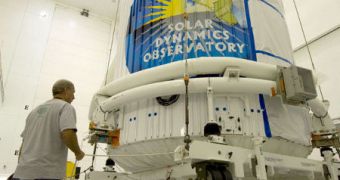The new NASA Solar Dynamics Observatory (SDO) is one of the first telescopes to be launched into space based on an idea that would have seemed heresy to the astronomical community just decades ago. The Sun is apparently a variable star, which is something of a new idea in scientific circles. The new instrument is designed specifically to understand these variations, which occur most energetically in extreme ultraviolet wavelengths (EUV). Slated for launch tomorrow, February 10, from the Cape Canaveral Air Force Station (CCAFS), in Florida, the SDO will provide more than five years of HD data on the star to ground controllers, Space reports.
The goal here is a fairly straightforward one, namely to improve space-weather forecasting. The Sun usually works in 11-year cycles, with periods of relatively intense activities followed by calmer ones. When the star is active, it produces many sunspots – areas of intense magnetism, but cooler than their surroundings –, which can erupt to cause solar flares, followed by coronal mass ejections. The most powerful solar flares can penetrate our planet's defenses, the magnetosphere, can wreck havoc in our power grids, satellites, and on the International Space Station (ISS).
In order to avoid such instances, and to minimize the devastation that such a radiation would produce, people need to be warned in due time, and this is where the new observatory steps in. “The unique characteristic of SDO is that it is designed to see everything all the time,” SDO project scientist Madhulika Guhathakurta, from the space agency's headquarters, in Washington DC, explains. What's also amazing about this telescope is that it will be in permanent contact with its controllers, sending the data equivalent of 500,000 songs daily. This means that the information will flow at a speed of 150 million bits per second, 24/7.
“It will be like the early days of weather forecasting,” NASA Goddard Space Flight Center (GSFC) SDO project scientist Dean Pesnell explains. “Solar flares in the extreme ultraviolet could be one of the new things that SDO contributes to space weather [knowledge]. They are not as energetic as X-ray flares but could affect the atmosphere,” he adds. The SDO will have sufficient fuel to last ten years, although the mission is only scheduled to last five. But experts are hopeful that extended funding would ensure that the spacecraft is operated at top capabilities for as long as possible.

 14 DAY TRIAL //
14 DAY TRIAL //